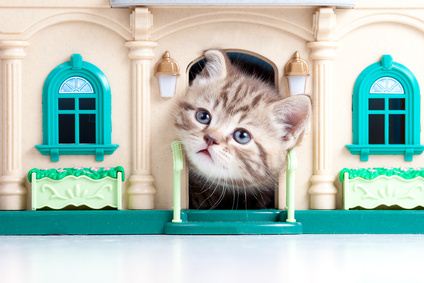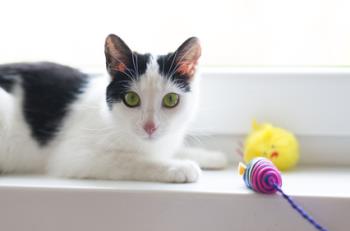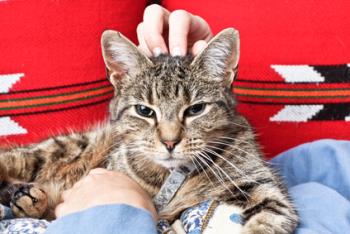Transitioning an outdoor cat to become an indoor cat is not as hard as many think. We have previously said that indoor life is much safer, but is that kind of lifestyle suitable for any cat? At some point, with all the meowing, sneaking around, and even spraying urine, it may seem your cat will never adapt to life indoors. That is not true!

In this article, you are going to learn how to bring your outdoor cat inside and turn him into an exclusively indoor cat. Furthermore, you are going to learn how to do so safely and in the least painful way for you and your cat.
- Enrich your cat’s indoor environment. When we were young and not that well educated in cat behavior, we tried bringing an outdoor cat inside without providing something for her to enjoy. It was a sure path to failure, as she was bored to death when we were not present. She was stressed and anxious about her confinement. Human households are not the most compelling environments for a cat, and, no matter how safe the indoor life is, it’s still a confinement.
You can’t just lock the door. If you restrict your cat’s outdoor access, something must be given in return!
You will need to expand your home’s vertical territory through the use of shelves, cat trees, and similar structures and also create locations where your cat can hide, stalk, play, sleep, or just enjoy a moment of peace. We list some great ways to improve your cat’s indoor environment here. - Transition your cat to indoor life abruptly. Most cat behavior modification methods use a gradual approach. Switch to a new food gradually, get your cat used to your new dog gradually, but bring your cat inside NOT gradually. Confinement is confinement, and it will cause a significant amount of stress no matter how gradually it’s done. The sooner your cat realizes “this is it” or “it’s all over,” the sooner his stress will diminish. So, outdoor access should be restricted in one step: close the door once, and never open it again. This is similar to quitting smoking; if you simply restrict yourself to one cigarette per day, you will only prolong your agony.
- The only exception is if you have an exclusively outdoor cat. In this case, before shutting the door, you want to lure him inside using food and get him accustomed to being indoors of his own free will. That is, if you want to successfully turn your exclusively outdoor cat into an indoor one, it is wiser to first turn him into an outdoor cat that comes in and goes out whenever he likes. We also feel that, in this case, you should rethink your reasons for wanting him to be an indoor cat.
Although we are great believers in the indoor lifestyle for cats, cats that are exclusively outdoor cats are not very promising candidates for becoming an indoor cat. Either turn him into an indoor/outdoor cat at first or leave things as they are.  Increase your cat’s play time. Cats are hunters, and they spend most of their time outdoors stalking, hunting, and playing with and eating their prey, even if they are still fed indoors.
Increase your cat’s play time. Cats are hunters, and they spend most of their time outdoors stalking, hunting, and playing with and eating their prey, even if they are still fed indoors.
When you block access to the outdoors, this kind of activity is lost. Something has to be given in return—play, that is, and preferably with your participation.
Get a fishing pole type toy, or a stick from a bush, and have several play sessions throughout the day. Move the toy like real prey would move (run away from the cat, hide, scratch the floor) and encourage the hunting drive in your cat. Learn more about playing with your cat here. If he was an active hunter before, he will need a lot of playing in order to use this energy appropriately.
Playing is also very beneficial for many other reasons and is an extremely powerful tool for distracting your cat’s attention from meowing at the door, which you can read more about below.- Make sure your cat is not able to escape. He will try to do so often and will literally guard the front door, waiting for you to open it. Therefore, whenever you come home or leave, make sure to block your cat’s way out, or, if possible, leave other doors closed that lead to the exit. Also, if you are ventilating a room by opening the window, make sure the cat is in another room. You can check here for more tips on preventing an indoor cat’s escape.
- Ignore your cat’s begging. In the process of turning an outdoor cat into an indoor one, you can be sure that he will meow his head off at the front door. We know that it’s not easy, but your only option is to ignore your cat’s meowing completely. Don’t punish your cat for this behavior, don’t shoo him away, and, for heaven’s sake, don’t let your cat out or give food as a bribe. Your cat MUST learn that his meowing gives no result. Give in to him a single time, and your cat will remember it forever. No result, no meowing. Cats are good at not wasting energy on things that give no result.
- Distract your cat before he starts to meow. As you try to ignore your cat meowing, you can also deter him from doing so in the first place. You may notice when he’s about to start meowing, such as when he’s heading to the front door. If you are able to catch this moment, distract him by getting out a toy and inviting him to play. To make it easier to “catch” these moments, you might use a little training aid in the form of a clicker. Read more about clicker training your cat here. If he responds, proceed with a play session for several minutes and pet him. Divert his thoughts away from the door.
This does not mean you have to quit your job to spy on him, but, the more often you are able to distract your cat, the faster he will learn to be calm and accept the indoor lifestyle.
There is also an easier way. Don’t overuse it, though. Meet a little training aid called SssCat.
It’s a motion detector combined with compressed air. Place it by the door and turn it on. Every time your cat (or you, sorry) tries to approach the door, a burst of air will scare your cat (but, hopefully, not you) away. For more information, please see our video on what’s in the box, how to set it up, and how to use the SssCat.  Do not restrict your cat unnecessarily. He is already confined, and there’s no need to add to this restriction by disallowing other actions. Of course, you should still maintain the normal house rules, such as not eating from your plate and not biting your hand or casting spells on you.
Do not restrict your cat unnecessarily. He is already confined, and there’s no need to add to this restriction by disallowing other actions. Of course, you should still maintain the normal house rules, such as not eating from your plate and not biting your hand or casting spells on you.
However, other actions such as jumping on the window sill, having access to all rooms, jumping in your lap, or sleeping in your bed should not be disallowed. Or you should at least allow most of them.
Why? Because every action you restrict decreases his wellbeing. The very act of confinement has already decreased it extremely (in his opinion); thus, decreasing it even more will lead him to believe that the indoor transition has ruined his life. We’ve seen it in our cat; her life enjoyment increased enormously when we stopped disallowing actions and there was no “shoo” at every corner she turned.
Feline pheromones, which send signals to your cat that everything is okay, might also make his life inside more pleasant and easier to adapt. You can read more about what pheromones are in this article.
How long will it take to turn your outdoor cat into an indoor one? It differs greatly from case to case. Of course, the transition itself, as mentioned above, will take only few minutes: you just decide not to let your cat out, and you never let him out.
How long it will take him to adapt, however, is another question. On average, you should see an enormous improvement in your cat’s behavior after just a few days—that is, if you get the “ignore and redirect” part mentioned above correct. However, your cat might still seek outdoor access every now and then. All you have to do is keep your cat’s life interesting.
